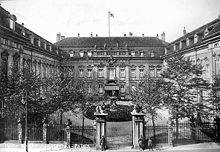Presidential Office
During the Nazi era, the Presidential Chancellery was the name of the office of the Reich President .
history
Prehistory and weakening of the Reich President
After the so-called seizure of power by the NSDAP with the appointment of Hitler as Reich Chancellor on January 30, 1933, the office of Reich President lost more and more of its importance. By the "so-called. Law to Remedy the Distress of the People and the Reich ", the Enabling Act of 24 March 1933 which went legislation (Art. 1 ErmächtigungsG) for a constitutional amendment law (Art. 2 S. 1 ErmächtigungsG) to the national government on . It thus stood on an equal footing with the Reichstag , which as an institution, like the Reichsrat , could not be touched (Art. 2 sentence 1 Enabling Act). Article 2 sentence 2 of the Empowerment Act stated explicitly that the rights of the Reich President remain unaffected, but this contradicted Art. 3 sentence 1 of the Empowerment Act, since the laws passed by the Reich Government were no longer issued and promulgated by the Reich President but by the Reich Chancellor . As a result, the Reich President no longer had the constitutional means to appeal against the legislature to the people . Thus the right of the Reich President from Article 70 of the Weimar Constitution (WRV) was de facto abolished. Likewise, the competences of the Reich President from Art. 48 Para. 2 WRV were practically suspended, since the Reich Government was now able to “take the measures necessary to restore public security and order” through its legislative competence .
Union of the offices of the Reich President and the Reich Chancellor
With the law on the head of state of the German Reich of August 1, 1934, with the death of Paul von Hindenburg, the union of his office as Reich President with that of Reich Chancellor was determined. After Hindenburg's death on August 2, 1934, Adolf Hitler renounced the official title of "Reich President" because Hindenburg had given the title of Reich President "a unique meaning", referring to "the greatness of the departed". At the same time, a subsequent referendum was ordered on the law that had already been implemented. This took place on August 19, 1934 and led to the result of 89.9% yes-votes.
A dissolution of the office of the Reich President or its incorporation into the Reich Chancellery would have been understandable. The head of the office, State Secretary Otto Meissner , approached Hitler with this suggestion and at the same time asked for his retirement . Both were rejected on the grounds that Hitler did not know how long both offices should remain united.
tasks
The office of the Reich President was renamed in 1934 to "Presidential Chancellery" and in 1937 to "Presidential Chancellery of the Führer and the Reich Chancellor" and from then until the collapse of 1945 it was responsible for representative and formal matters such as the appointment of officials, mercy, medals and titles and protocol tasks. The WRV forbade the awarding of medals and decorations as well as the acceptance of foreign orders and titles (Art. 109 WRV), but the total ban on medals did not prevail in practice, as the states continued to award the life-saving medal and the Reich President did this to foreign state guests Decoration of honor of the German Red Cross - which did not fall under the state prohibition of medals, as the German Red Cross was organized under private law - awarded. For intellectual and artistic merit, the Reich President created the “ Eagle Shield of the German Reich ” in 1922 and the “ Goethe Medal for Art and Science ” on the occasion of the 100th anniversary of Goethe's death . These were awards that could not be worn by the "bearer", that is to say, " showcase orders ".
During the National Socialist tyranny - especially during the Second World War - a large number of orders and decorations were donated, which the Presidential Chancellery was responsible for awarding them, provided that they were not awards from the NSDAP or its branches. This had led to an increase in the number of jobs that was merely administrative but politically insignificant.
Predecessor and successor organizations
- Functional predecessor in the Weimar Republic was the office of the Reich President
- The office of the Federal President is the successor to this function in the Federal Republic of Germany
literature
- RGBl. 1933 I p. 141.
- RGBl. 1934 I, p. 747.
- Franz Spath: The Office of the Federal President. Düsseldorf 1995.
- Jens Hannig: Structure and functioning of the office of the Federal President. Marburg 2005.
Individual evidence
- ↑ Horst Mühleisen: Hindenburg's testament from May 11, 1934 . In: Karl Dietrich Bracher, Hans-Peter Schwarz, Horst Möller (Hrsg.): Quarterly books for contemporary history . 44th year, no. 3 . R. Oldenbourg Verlag, July 1996, ISSN 0042-5702 , p. 365 ( PDF [accessed February 1, 2016]).
-
↑ Wolfgang Benz (ed.): Enzyklopädie des Nationalozialismus , Klett-Cotta, Stuttgart 1997, ISBN 3-608-91805-1 , p. 652.
Maurizio Bach, Stefan Breuer: Faschismus als Movement and Regime. Italy and Germany in comparison. VS Verlag für Sozialwissenschaften, Wiesbaden 2010, ISBN 978-3531920306 , p. 251.
